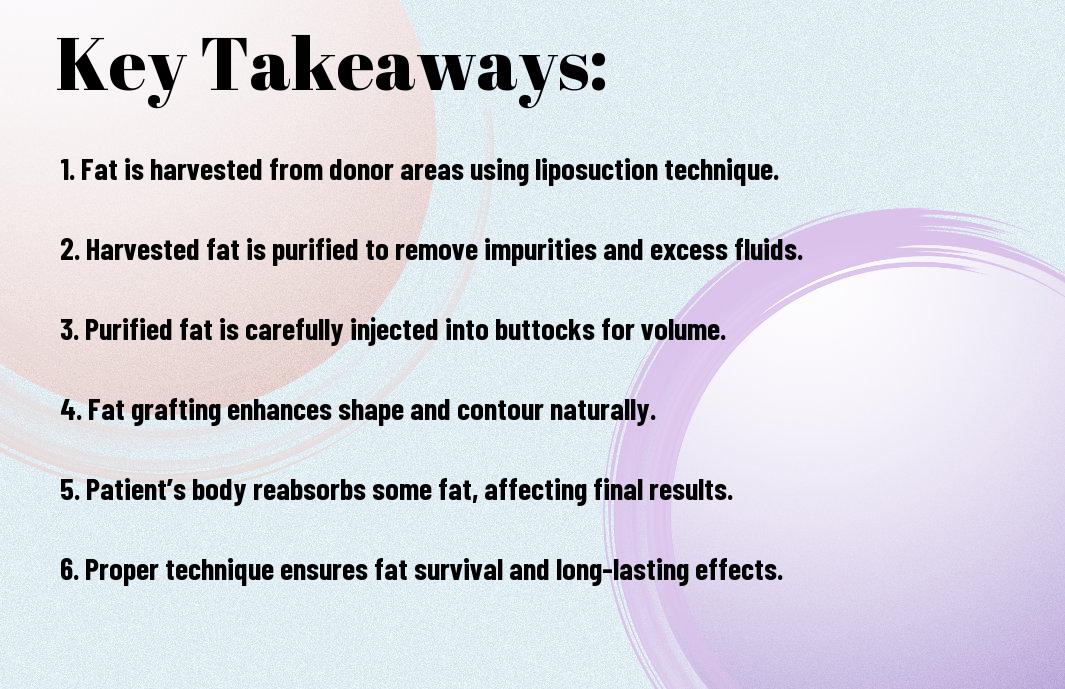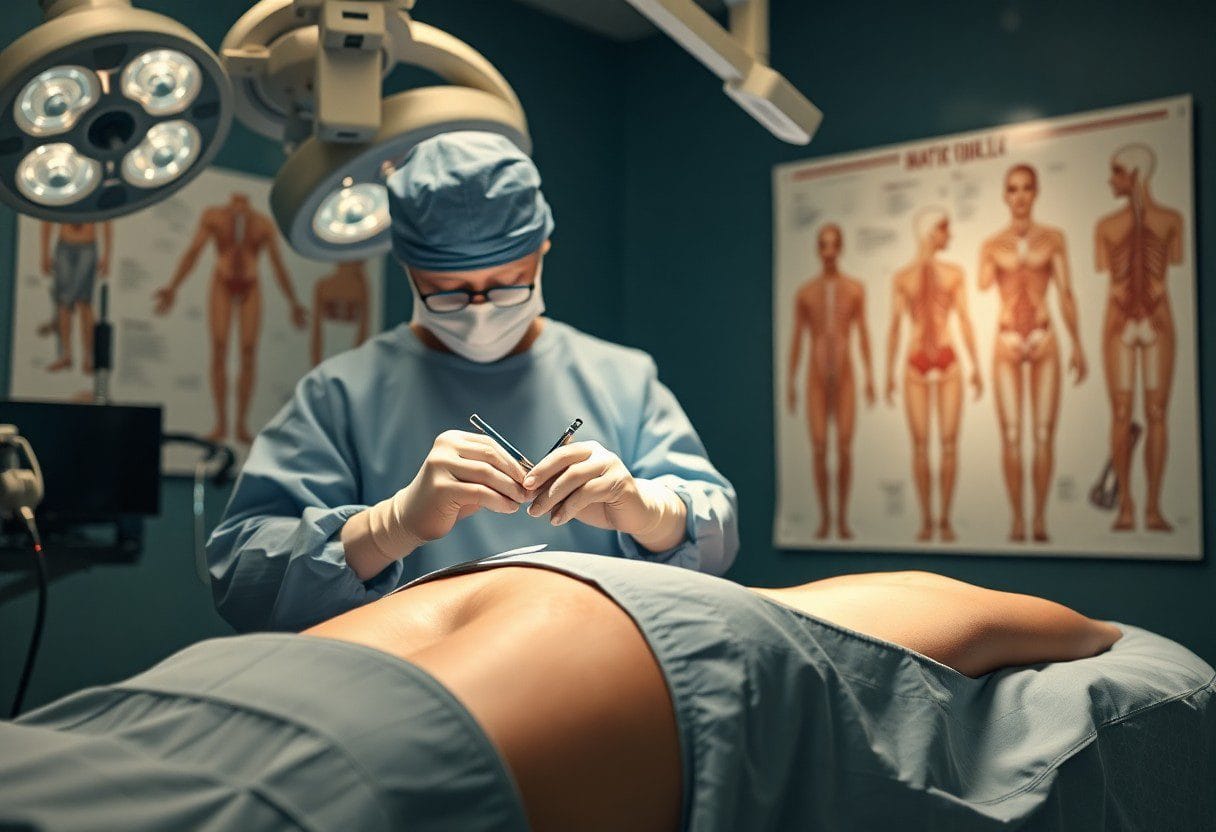Just as you explore options for enhancing your curves, understanding the fat grafting process in a Brazilian Butt Lift (BBL) can empower your decision-making. This innovative procedure involves liposuction to harvest fat from your own body, typically from areas like the abdomen or thighs, which is then purified and strategically injected into your buttocks. By using your own fat, you not only achieve natural-looking results but also contour other areas of your body, enhancing your overall silhouette. Dive deeper into how this transformative approach works and what you can expect during the process.

The Science of Fat Harvesting
Fat harvesting is a pivotal step in the Brazilian Butt Lift, involving the extraction of excess fat from targeted body areas. By utilizing techniques like liposuction, your surgeon focuses on areas such as the abdomen, thighs, or flanks. The extracted fat is then prepared for grafting, ensuring that it remains viable and healthy to achieve optimal results. Understanding the methods and processes behind fat harvesting helps you appreciate the complexity and artistry involved in sculpting your ideal silhouette.
Techniques for Liposuction
Several liposuction techniques can be employed during fat harvesting, with popular options including tumescent, ultrasound-assisted (UAL), and laser-assisted (LAL) methods. Each technique has its benefits depending on your individual body and goals. Tumescent liposuction, for example, involves injecting a saline solution to minimize bleeding and enhance fat removal, resulting in a smoother overall experience and faster recovery time.
The Role of Fat Quality in Grafting
Fat quality plays a significant role in the success of the grafting process during a Brazilian Butt Lift. Grafted fat cells must be healthy and intact to survive the transfer and integrate into the new area effectively. Factors such as the harvesting technique, the patient’s overall health, and even the purity of the extracted fat impact the final outcome, as only a portion of transferred fat generally survives long-term.
High-quality fat retains its cellular integrity, imperative for successful grafting. This means careful consideration is given to how fat is harvested and processed. Ensuring the fat is appropriately purified from unwanted fluids and debris not only increases the chances of fat survival but enhances your aesthetic results. Clinical studies show that better-quality fat can lead to a higher retention rate—typically around 60-80% of grafted fat remains after six months if harvested correctly, translating to more permanent volume and shape for your buttocks. The overall aesthetic and longevity of your results significantly hinge on the quality of fat that will ultimately create the curves you desire.
The Art of Fat Grafting
Fat grafting combines science with artistry, allowing a skilled surgeon to enhance your body contours by transferring fat from one area to another. This method not only results in a fuller, shapelier appearance for your buttocks but also improves the aesthetics of the donor site. Proper technique in fat extraction, preparation, and injection plays a significant role in achieving a balanced, natural look, making this process a refined skill that requires experience and an eye for detail.
Preparing the Fat for Injection
Once harvested, the fat undergoes a meticulous purification process to enhance viability and ensure optimal results. The surgeon uses centrifugation or filtration methods to eliminate impurities and separate the viable fat cells from blood and oil. Ensuring that only the healthiest cells are used for injection is key to maximizing retention and achieving a smooth, natural contour in your buttocks.
Strategic Placement for Optimal Results
Effective fat grafting relies heavily on the surgeon’s ability to strategically place the fat for maximum impact. Utilizing precise injection techniques, fat is distributed at various depths and locations throughout the gluteal tissues. This allows for a more rounded and voluptuous appearance, while also ensuring that the transferred fat will have adequate blood supply for survival.
During the Brazilian Butt Lift, your surgeon’s expertise in strategic fat placement can greatly affect the final results. By depositing fat in specific layers of the gluteal muscle and subcutaneous tissue, they create a harmonious, natural shape that enhances your unique body proportions. This thoughtful approach to fat distribution not only minimizes the risk of complications, such as asymmetry, but also promotes better integration and retention of the grafted fat cells, leading to longer-lasting results. Most patients report a noticeable improvement in not just size and shape but also in overall body confidence as they see their desired curves come to life.
The Transformation Process
Your Brazilian Butt Lift journey doesn’t merely involve the extraction and reinjection of fat; it’s a meticulous transformation process. It begins with liposuction, where unwanted fat is harvested from areas like the abdomen or thighs. This harvested fat is then purified and strategically reinjected into specific sites of your buttocks. The goal is to create a naturally attractive shape and enhance volume, reshaping your silhouette into a fuller, proportionate form. By reframing your body’s contours and improving your curves, this process leads to a significantly rejuvenated appearance.
Understanding How Fat Integrates with Tissue
The Importance of Blood Supply in Survival Rates

Managing Expectations: Risks and Results
Every cosmetic procedure comes with a unique set of risks and potential outcomes, and a Brazilian Butt Lift (BBL) is no different. Understanding the possible complications is vital for aligning your expectations with evident realities. Factors such as your overall health, the skill of your surgeon, and adherence to post-operative care can all influence your final results and recovery journey. By being fully informed and prepared, you can approach the process with a clearer outlook.
Common Concerns and Complications
Concerns surrounding a BBL often include fat necrosis, seroma formation, and asymmetry. Fat necrosis occurs when some transplanted fat cells fail to survive, which can cause lumps or hard areas in your buttocks. While these complications can be largely mitigated by choosing a skilled surgeon experienced in BBL techniques, being aware of them prepares you for anything that might arise during your recovery.
Realistic Outcomes and Recovery Timeline
Realistic expectations of your BBL results are paramount for satisfaction. Most patients can expect to see a noticeable enhancement after surgery, although final results may take up to 6 months for full maturation. During this recovery period, some swelling is expected, leading to variations in your appearance as healing progresses. Sticking closely to post-operative instructions will enhance your results and expedite your recovery.
Typically, the initial recovery period lasts about two weeks, during which you may experience discomfort and limited mobility. The swelling usually subsides significantly in the first month, but residual swelling can linger for a bit longer. Once you pass the 3-month mark, most individuals notice a substantial improvement in their contours, with full results becoming more apparent around the 6-month point. Staying active while allowing your body to heal will not only support recovery but also optimize the aesthetic results you desire.
Beyond Aesthetic Appeal: The Psychological Impact
The psychological effects of a Brazilian Butt Lift often extend well beyond physical enhancement. You’re likely to experience significant shifts in your self-esteem and body image, allowing you to embrace your silhouette and feel empowered in your own skin. For many, these changes are transformative, facilitating a newfound confidence that permeates various aspects of life, from personal relationships to professional environments.
Body Image and Self-Confidence Boost
A boost in self-confidence is among the most profound rewards of undergoing a Brazilian Butt Lift. As you admire your enhanced body shape in the mirror, many individuals report feeling more attractive and self-assured in social settings. This revitalized body image can lead to engaging more freely in activities you might have previously avoided, reinforcing a positive self-perception that resonates deeply throughout your life.
Emotional Considerations After a Brazilian Butt Lift
While the aesthetic outcomes of the procedure often lead to a positive emotional state, some individuals may experience a range of feelings shortly after surgery. The adjustment period, when dealing with pain, swelling, and recovery, can evoke anxiety or uncertainty. Surrounding yourself with supportive people and remaining patient during your healing process is vital as you navigate the emotional landscape that accompanies significant body changes.
Many individuals find that the emotional rollercoaster post-surgery can be intense, especially when facing the contrast between the anticipation and reality of recovery. Fluxes in mood and self-image-related anxiety may surface, particularly as you manage the physical changes alongside your everyday life. Open communication with friends, family, or a mental health professional can provide reassurance and guidance, helping you to process these shifts effectively. Engaging in activities that boost your mood, from light exercise to pursuing hobbies, can enhance your emotional well-being during this time. Ultimately, focusing on self-care and allowing yourself the space to adapt will cultivate a more positive emotional outcome as you transition into life post-Brazilian Butt Lift.
Summing up
Following this, fat grafting in a Brazilian Butt Lift procedure involves extracting fat from your body through liposuction and then injecting it into your buttocks. This process not only enhances the shape and volume of your backside but also ensures a natural look since the fat used is your own. The technique promotes tissue integration, allowing for lasting results as long as you maintain a stable weight. Overall, understanding how fat grafting works can help you make informed decisions about your body enhancement journey.
FAQ
Q: What is the fat grafting process in a Brazilian Butt Lift?
A: In a Brazilian Butt Lift (BBL), fat grafting involves several steps. First, a surgeon performs liposuction to remove fat from areas where it is excess, such as the abdomen, thighs, or flanks. This harvested fat is then purified and prepared for injection. Finally, the surgeon injects the processed fat into specific areas of the buttocks to enhance their shape and size. This technique uses the body’s own fat to create a natural appearance, avoiding the use of implants.
Q: How long do the results of fat grafting in a Brazilian Butt Lift last?
A: The longevity of results from fat grafting in a BBL can vary. Typically, a portion of the transferred fat will be absorbed by the body in the weeks and months following the procedure. However, most patients can expect to retain about 60-80% of the injected fat after the healing period. To maximize and maintain results, patients are advised to maintain a stable weight and a healthy lifestyle. Follow-up consultations with the surgeon can provide guidance on preserving the new look.
Q: Are there any risks associated with fat grafting in a Brazilian Butt Lift?
A: As with any surgical procedure, there are potential risks involved in fat grafting for a BBL. Some of these risks include infection, asymmetry, excessive swelling, or hematoma. Additionally, there is a small risk of fat embolism, where fat enters the bloodstream and causes serious complications. It’s vital for patients to choose a qualified, board-certified plastic surgeon who can assess individual risk factors, provide detailed pre-operative instructions, and ensure a safe surgical experience.